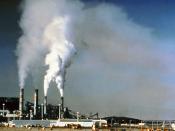Latest Trends of Pollution
�
Latest Trends of Pollution
Introduction
Today, pollution is occurring on a vast and unprecedented scale worldwide, impacting virtually everyone and everything. We can best understand the dramatic changes or increase in pollution in the 20th and 21st centuries in terms of four long-term trends.
First, the world's population increased more than threefold in the 20th century, along with a twentyfold increase in the gross world product. These increases caused a demand on the use of fossil fuels, thereby increasing the release of both sulfur dioxide and nitrogen oxide into the atmosphere. These emissions are the principal components of smog and give rise to acid rain (Speth, 1998).
The second long-term pollution trend recognized in the 21st century is the shift from gross environmental results to micro toxicity. Before World War II, the major public health issues centered on smoke and sewer-related issues. One incident, the killer fog over Donora, Pennsylvania, in 1948, sickened thousands and killed 20 people.
An even more ominous micro-level threat has existed since the advent of nuclear technology. The ushering in of the nuclear age, chemical, biological, and nuclear warfare, and the peacetime applications of these technologies-such as agribusiness fertilization and power generation-has led to the development and widespread use of chemical, biological, and radioactive material, thus creating waste storage issues for generations to come.
The third environmental pollution trend is its global spread. Once thought to be a problem of the rich or more developed nations, pollution is now a serious problem for less-developed countries as well. For example, with the explosion of industrialization in both China and India, these countries are experiencing environmental pollution problems on a national scale that threaten the quality of life for both rural and urban residents. Moreover, data from the UN Global Environmental Monitoring...


